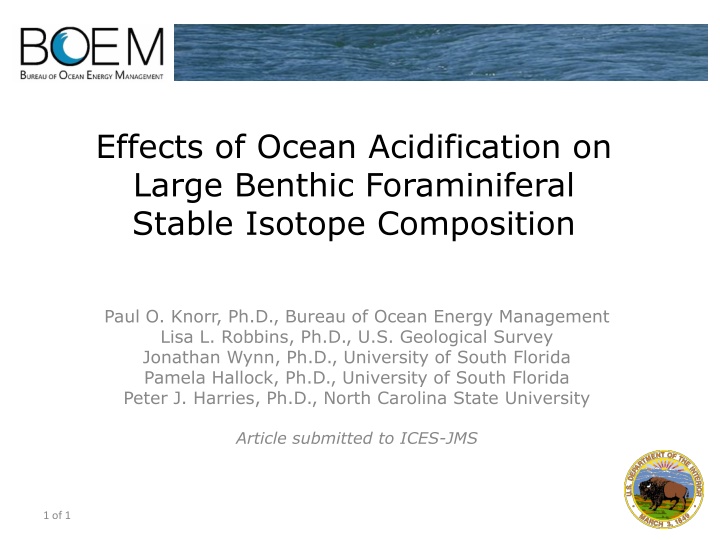
Effects of Ocean Acidification on Large Benthic Foraminiferal Stable Isotope Composition
This research article explores the impact of ocean acidification on the stable isotope composition of large benthic foraminifera. The study investigates calcite saturation state under different pH and CO32- conditions, emphasizing the effects on Miliolid and Rotalid foraminifera. Results show significant changes in isotopic ratios between pH levels, highlighting the importance of understanding these ecological responses to ocean acidification.
Download Presentation

Please find below an Image/Link to download the presentation.
The content on the website is provided AS IS for your information and personal use only. It may not be sold, licensed, or shared on other websites without obtaining consent from the author. If you encounter any issues during the download, it is possible that the publisher has removed the file from their server.
You are allowed to download the files provided on this website for personal or commercial use, subject to the condition that they are used lawfully. All files are the property of their respective owners.
The content on the website is provided AS IS for your information and personal use only. It may not be sold, licensed, or shared on other websites without obtaining consent from the author.
E N D
Presentation Transcript
Effects of Ocean Acidification on Large Benthic Foraminiferal Stable Isotope Composition Paul O. Knorr, Ph.D., Bureau of Ocean Energy Management Lisa L. Robbins, Ph.D., U.S. Geological Survey Jonathan Wynn, Ph.D., University of South Florida Pamela Hallock, Ph.D., University of South Florida Peter J. Harries, Ph.D., North Carolina State University Article submitted to ICES-JMS 1 of 1
calcite vs pCO2 8.0 Saturation state = calcite=[Ca2+][CO32 ]) Ksp(???????) calcite Control (pH 8.0, Alkalinity is 10% CO32-, ~2025) 4.4 Treatment (pH 7.6, 4% CO32-, ~2140) 2.0 0 470 1300 3000 pCO2 ( atm) 2 2
Large Benthic Forams Miliolid (Miliolida) Porcelaneous Imperforate High-Mg calcite Rotalid (Rotaliida) Hyaline Perforate Low-Mg calcite Archaias angulatus Amphistegina gibbosa 2 mm 2 mm 3 3
Miliolid Calcification Modified after Ter Kuile et al. (1989) and Cotey and Hallock (1988) 4 4
Rotalid Calcification Modified after ter Kuile et al. (1989) and De Nooijer et al. (2014) 5 5
Sample Location Miliolid Rotalid 6 6
Apparatus pH and Alkalinity analysis using Ocean Optics spectrophotometers Stable isotope analysis using Thermo Delta V IRMS w/ Gasbench II, 2 < 0.1 Referenced Guide to best practices for OA research and data reporting (2010) 7 7
Tank Chemistry 8 8
Results n = 30 9 9
Results 2 Miliolid pH 7.6 Miliolid pH 8.0 1 Rotalid pH 7.6 18O 0 -2 -1 0 1 -1 Rotalid pH 8.0 13C -2 10 10
Significance Miliolid p < 0.005 Rotalid p < 0.005 18O 13C NS (p = 0.25) p < 0.001 Tukey s pairwise method 11 11
Interpretation Miliolid 18O fractionation dependent on carbon speciation: HCO3-16 > CO32- (Less CO32- at low pH) 13C not correlated to carbon speciation, no vital effect on carbon pool Rotalid 18O fractionation dependent on carbon speciation 13C consequence of vital effect on internal carbon pool; diatom endosymbionts may benefit from increased CO2 12 12
